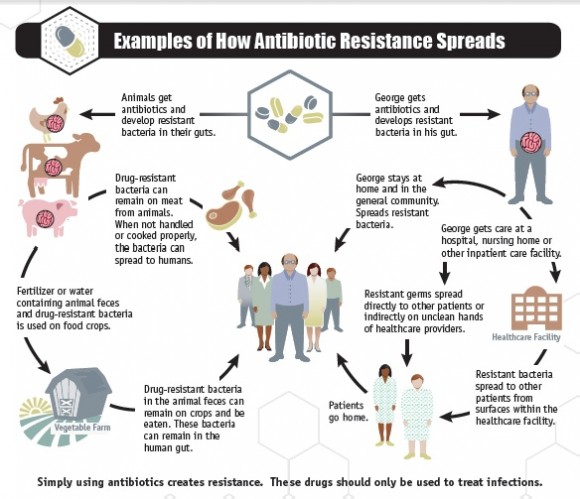When people talk about factory farming and modern agricultural practices, we tend to think about pollution, animal cruelty, and fattened, hormone-filled meat. These are definitely important concerns; but there is an even more insidious problem that can become a major threat to public health– antibiotic-resistant infections.
Right now, 80% of the antibiotics made in the U.S. are fed to factory-farmed animals to promote growth and to counter unsanitary living conditions. Most of this ends up in manure, which is used to fertilize our vegetables. The rest of this 80% remains in the meat that we will eat. Throughout this process, bacteria have countless opportunities to be exposed to antibiotics in small amounts. The low concentrations of these drugs don’t wipe out all the germs in the animal/region/food, but they kill enough non-resistant bugs that the ones who happen to be resistant would have less competition for resources. With more space and nutrients available to them, antibiotic-resistant bacteria are free to grow out of control and completely take over whichever animal/region/food the antibiotics happen to be in. In addition, resistant bacteria have the ability to copy their DNA and transfer it to their non-resistant peers.
Here’s the CDC’s illustration of the chain of resistance and infection:
If there are high enough numbers of these bacteria, they will become pathogenic and cause diseases. And the most concerning part is that these are the same medicines that are used to treat human diseases. So if someone shows up to the hospital with resistant infections, the drugs would no longer work.
This is exactly what’s been happening with the recent outbreak of Salmonella in the United States. So far, about 500 people have been infected in 25 states. There are seven strains of bacteria involved, all of which are resistant to antibiotics. This has been traced back to a poultry producer in California that – you guessed it – use antibiotics in their animal feed.
The CDC estimates that at least 2 million Americans end up in the hospital with antibiotic-resistant infections each year, and this number is increasing.
There is no doubt that antibiotic resistant is a major problem. But New York representative Louise Slaughter proposed a bill last year called the Preservation of Antibiotics for Medical Treatment Act (PAMTA) that, if passed, would require the FDA to re-review its approval for seven major classes of antibiotics used in agriculture that are also important for human infections. This could mean huge changes in the way factory farms work. Unfortunately, there has been so much lobbying against this bill that it has been referred to committee and pretty much forgotten. My advocacy project is trying to drum up support for PAMTA through a petition and a letter to our representative, Glenn Thompson. But even if this bill is never passed, hopefully people will become more aware of this issue and more things will be done to address it.
Partial List of Sources:
http://www.steiros.com/Antibiotic_Stewardship.html
http://www.fosterfarms.com/about/raise.asp








